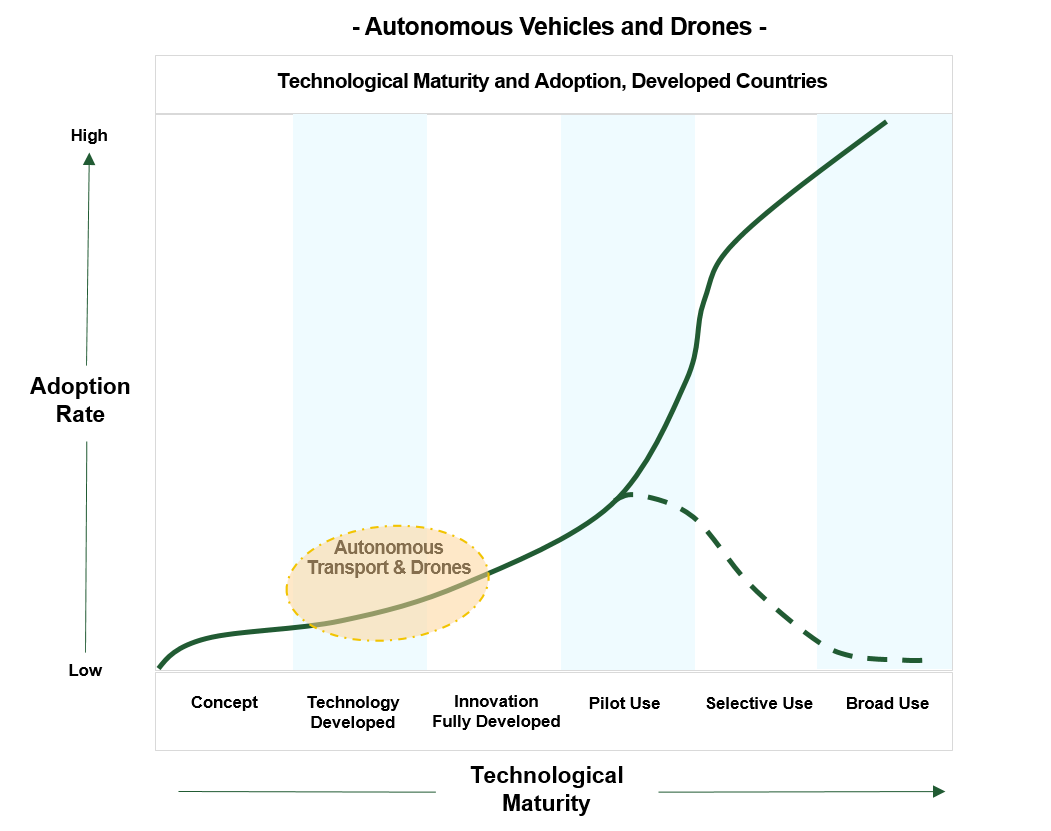UNMANNED VEHICLES, TYPES AND EVOLUTION
Unmanned Vehicles are any vehicles managed without crew. There is a broad variety of air, ground, sea, undersea or aero spatial Unmanned Vehicles, with different functions conducted with a spectrum of autonomy that ranges from completely controlled by humans to fully Autonomous Vehicles.
Remotely Controlled Vehicles
These are vehicles managed remotely by humans with different degrees of system’s assistance. They have been developed by the military first and hobbyist latter with a broad adoption for specific uses and include different kind of ground, submarine, aero spatial and air combat vehicles, plus miniaturized aerial RCs for security, hobby and recently small freight delivery use.
AI and Robotics Powered Autonomous Vehicles
Already generating powered with the latest advancements in IoT, AI, Robotics plus geolocation are able to read, analyze, communicate with their environment and conduct all driving tasks without human intervention. In between R.C. And Fully Autonomous Vehicles there is a broad range of machine assisted human controlled vehicles, and semiautonomous vehicles with only human supervision and partial conduction.
AUTONOMOUS VEHICLES EFFECTS AND ADOPTION
Some autonomous vehicles are fully operational, cost effective and deployed for certain uses in particular in warehousing and air operations technologies continue advancing and early adopters are experimenting with broader deployment. Adoption is being limited by the fact that the more autonomous they become, the more disruptive the effects can be on the rest of manned vehicles and human operations.

CETMO Analysis, adapted from McKinsey & Company (4)
Autonomous Vehicles’ disruptive effect requires for administrative regulation and in some cases new public infrastructure. These requirements range enormously depending if they are for ground usage which generates the most complex situation and requires the maximum degree of regulation plus infrastructure, aerial that requires air space control or sea and undersea operations that require less control. These are the main present barrier to a broader adoption of this KETTL in the areas of potential largest value creation.
Indeed, is this need for regulation and infrastructure plus the need for some radical changes in customer behavior that is limiting their broader present use by most sectors. For this reason, and while research and experimentation continues in particular in the less congested spaces like air and sea, most present and near future broad use of Unmanned vehicles is focused on Partially Autonomous Vehicles.
AUTONOMOUS TRUCKS (A.T.s) AND AUTONOMOUS CARS STILL IMMATURE
Along with autonomous cars, the area with major economic and social potential impact are ATs that similarly to autonomous cars are still technologically immature. ATs are advancing from fully manned truck platooning to truck platooning with a single driver in the leading truck, expected to be technologically ready in 2-5 years.
Autonomous platooning trucks unmanned for straight highway driving is expected to be mature in 5 to 7 years while full elimination of on-truck driver is expected to require 7 to 10 years. (1). As immature but potentially disruptive technology it is broadly advised for operators, corporations and administrations in Transport and Logistics to be appraised of ATs evolution and future advancements.
UNMANNED AERIAL VEHICLES (U.A.V) –DRONES, USES AND IMPACT
Unlike ATs and autonomous cars, Drones are technologically more mature, available and its way to broader deployment, Drones range from remotely controlled to those that can fly autonomously through software controlled fight plans and IoT embedded sensors. As the rest of Unmanned vehicles most fall under the Partially Autonomous section.
Commercial Drones for corporate and consumer applications are already broadly used mainly in monitoring and surveillance functions for public safety, installation and infrastructure control, agricultural, telecommunications and energy exploration activities among others while being explored on freight
Some other uses that are already technologically mature besides short and long-range surveillance are image taking and analysis, facilitation of some labor intensive or difficult tasks, entertainment and advertising and to providing multimedia bandwidth.
Commercial scale Drone Freight Transport is expected to be technologically mature in 5 to 7 years and passenger in 7 to 12 years (2) (3). Drones are expected to generate a large economic impact, as an illustration the estimated annual impact on the GDP of the USA is $31 billion to $46 billion annually by 2026. (3) Limitations are the already commented need for regulation, integration with national and international air systems, infrastructure, public acceptance and further advancements in battery, detect-and-avoid and location technologies.
UNMANNED VEHICLES IMPACT ON DEVELOPING COUNTRIES
In Developing Countries Drones are ready to generate significant value in many areas, for example in agriculture surveillance, seeding and fertilization. Regarding Transport Drones can bridge and leapfrog the transport infrastructure gap and provide transport of high-social value items like medical equipment and vaccines at high speed and lower costs in areas with limited or even non-existent roads. Also allow to rethink future transport infrastructure planning and construction focusing the investments on main roads and railways and leaving last mile transport to Drones.
References:
Autonomous vehicles and drones and their integrated technologies in AI, robotization and IoT have evolved enormously. Because of their initially minor carrying capacity and lower cost per unit will result in a net increase of the number of vehicles in a given fleet which has the potential to create a cascade of effects. In the case of Transport effects may range from better planning, lower traffic congestion, labor redistribution to more capillary distribution.
Freight Transport
Improved Traffic Fluidity and Congestion Reduction: autonomous Vehicles and Drones, because of their initially minor carrying capacity and lower cost per unit will increase the number of vehicles in a given fleet, allowing a better adjustment demand-supply and planning, reducing infrastructure congestion (roads, sea routes and airspace).
On the other side, and due to the large volume of vehicles, routes are likely to have to be planned and approved slots, as is currently the case in air transport. In later stages, control center authorities may need to be set up to streamline and control traffic, as well as resolve potential conflicts of interest.
Decrease in Personnel Directly Involved in Operations such as driving and handling machinery in favor of “controller” tasks, improvement of “current” systems and maintenance. The staff, not being physically involved in the operation, will be able to enjoy a less difficult and risky environment. Hourly limitations, due to agreements and employment contracts or tachograph restrictions, will be modified in a first phase. In a later phase of total vehicle autonomy, the limitations will be only restricted to energy self-sufficiency.
Increased Distribution Capillarity to remote or non-strategic locations or with little strategic positioning for transport companies. For example, depopulated regions far from large urbanizations or industrial areas,
Increased Remote Surveillance and security in large infrastructures like terminals, ports, and airports.
Passenger Transport
Congestion Reduction: Autonomous vehicles supported by analytics, allow for capacity management, scheduling and route picking, which combined with a reduction of space to operate results in system capacity increase and improved traffic flow.
Operations Optimization and New Services: for operators there are potential significant reductions of service operation resources, resources that can be redistributed to perform other tasks within the service or additional services. Examples are capillarity increase of the transportation system with last mile services by unmanned vehicles. Autonomous Vehicles will also allow the definitive deployment of transport on demand.
Greater Travel Safety: when traveling by automating driving, both for users and for staff who will be able to steer travelers remotely if needed.
Realignment of Labor and Skills: The redistribution of the human resources of the operating company (by reducing the need to have driving staff) can be a very important opportunity for improvement in the direct contact with the customer, for example, customer service agents onboard.
Improved Remote Surveillance and Incident Response: similarly to Freight Transport, drones facilitate surveillance of installations and critical infrastructure. Additionally, drones allow near to immediate response to incidents and service problems and significant efficiency and effectiveness gain in inspection and maintenance tasks.
Sources: CETMO and “Impacte de les KETs en la digitalització dels diferents àmbits del transport”, CENIT-CINESI – December 2020
With the support of:

Contact
Av. de Josep Tarradellas, 40, entresol
08029 Barcelona
Tel: 00 34 93 430 52 35
